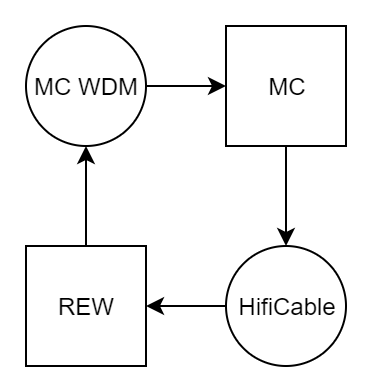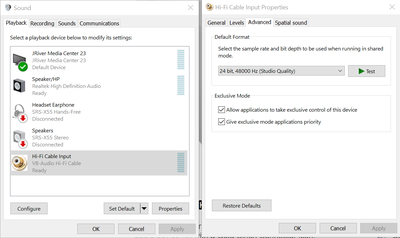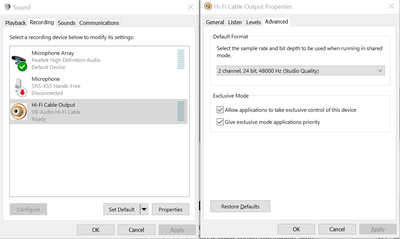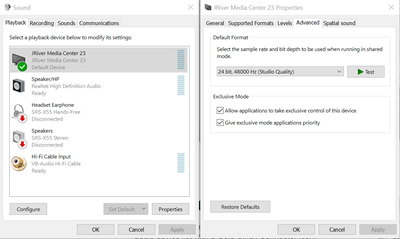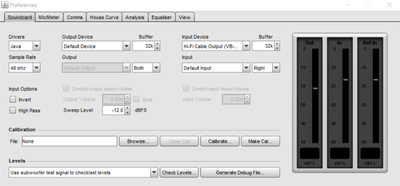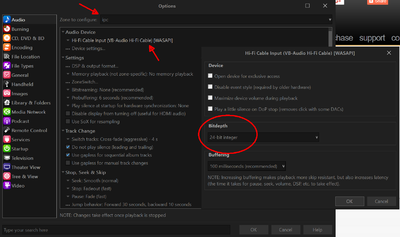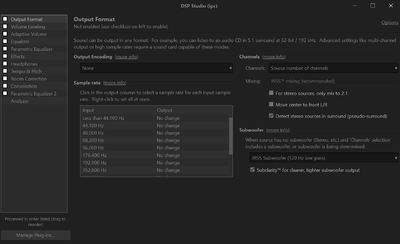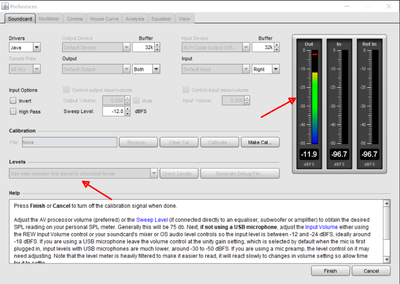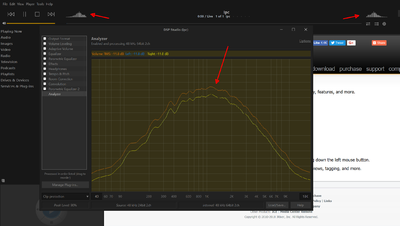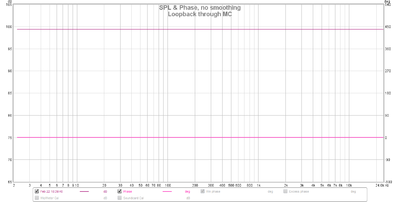Verifying DSP Studio: Difference between revisions
No edit summary |
No edit summary |
||
| Line 91: | Line 91: | ||
===== Verify the Signal Chain ===== |
===== Verify the Signal Chain ===== |
||
* Play a test signal |
|||
Open the REW generator |
|||
** Launch REW |
|||
Play pink noise |
|||
** Open the Preferences screen |
|||
Check the output meters go up |
|||
** Go to the Soundcard tab |
|||
** Select "Use Main Speaker test signal to check/set levels" |
|||
** Click "Check Levels" |
|||
** Click "Next >" |
|||
** Confirm the output meter shows some signal is playing normally (NB: the input meters may also rise) |
|||
[[File:rew_output_test.png|frameless|400px]] |
|||
| ⚫ | |||
| ⚫ | |||
* Verify MC is receiving and playing that signal |
|||
Back to REW |
|||
** Open MC |
|||
Check the input meters are moving |
|||
| ⚫ | |||
** Go to the Analyser page |
|||
| ⚫ | |||
[[File:mc_output_test.png|frameless|400px]] |
|||
Stop the noise |
|||
Now measure a sweep |
|||
* Verify REW is receiving the output from MC |
|||
Check it records successfully (i.e. you have a flat line in the sweep) |
|||
** Return to the REW Preferences/Soundcard tab |
|||
** Check the input meters have risen to meet the input signal |
|||
** Click "Finish" to stop the signal |
|||
[[File:rew_input_test.png|frameless|400px]] |
|||
* Verify the end to end signal chain results in a passthrough, i.e. has flat frequency response |
|||
** Close the REW Preferences screen |
|||
** Click the "Measure" button |
|||
** Set the following options |
|||
*** No Timing Reference |
|||
*** Start Freq: 2 |
|||
*** End Pref: 24000 |
|||
*** Level: -12.0 |
|||
*** Length: 256k |
|||
*** Sweeps: 1 |
|||
*** Output: Default Output/Both |
|||
** Click "Start Measuring" |
|||
*** you should now see the measurement sweep complete normally and display a flat frequency response from 2-24kHz in the resulting SPL screen |
|||
[[File:rew_measure_test.png|frameless|400px]] |
|||
Revision as of 18:42, 22 February 2018
This Page is a Work in Progress
Overview
DSP Studio has a lot of options which interact with each other and it can be easy to make small mistakes that negatively impact sound quality. The ability to measure the output from Media Centre is therefore an extremely useful thing to be able to do. This page describes how to do this using freely available tools.
Platform Limitations
The ability to route external audio input through JRiver is only implemented on Windows.
Linux and MacOS users will need JRiver to play the test signal instead. This is described in [insert section here]
ASIO vs WDM
Windows users can choose between two input methods:
ASIO is typically preferred if the hardware supports it, this usually means you are using a pro audio interface.
Examples will be given using both methods.
Setup
Common Steps
Room EQ Wizard (REW)
Install REW from https://www.roomeqwizard.com/beta.html (note that the beta version is the generally recommended version to use)
Windows: WDM Setup
Media Centre
Ensure the feature is activated and working as per the instructions in WDM_Driver
Creating a MC -> REW Audio Path
The target signal chain is
HifiCable
Install HifiCable from https://www.vb-audio.com/Cable/ (scroll to the bottom to find the HifiCable & ASIO Bridge package)
Open each audio device in the Windows Mixer in turn and ensure that each one is set to 2 channel, 24bit, 48000Hz operation
There are three devices to be configured
- Hi-Fi Cable Playback
- Hi-Fi Cable Recording
- MC WDM Playback
Configure REW
Launch REW and open the preferences screen. Set the following options on the Soundcard tab
- Drivers: Java
- Sample Rate: 48kHz
- Output Device: Default Device
- Input Device: Hi-Fi Cable Output (VB-Audio Hi-Fi Cable)
Configure MC
Launch MC and open the options screen, select the Audio page and choose the IPC zone. Set the following options;
- Audio Device: Hi-Fi Cable Input (VB-Audio Hi-Fi Cable) [WASAPI]
- Bitdepth: 24bit
NB: The bitdepth option is accessed via the "Device Settings..." option
Open DSP Studio, deselect all blocks including output format.
Verify the Signal Chain
- Play a test signal
- Launch REW
- Open the Preferences screen
- Go to the Soundcard tab
- Select "Use Main Speaker test signal to check/set levels"
- Click "Check Levels"
- Click "Next >"
- Confirm the output meter shows some signal is playing normally (NB: the input meters may also rise)
- Verify MC is receiving and playing that signal
- Open MC
- Open DSP Studio
- Go to the Analyser page
- Check the analyser displays a wobbling straight line (i.e. is seeing and playing the test pink noise signal)
- Verify REW is receiving the output from MC
- Return to the REW Preferences/Soundcard tab
- Check the input meters have risen to meet the input signal
- Click "Finish" to stop the signal
- Verify the end to end signal chain results in a passthrough, i.e. has flat frequency response
- Close the REW Preferences screen
- Click the "Measure" button
- Set the following options
- No Timing Reference
- Start Freq: 2
- End Pref: 24000
- Level: -12.0
- Length: 256k
- Sweeps: 1
- Output: Default Output/Both
- Click "Start Measuring"
- you should now see the measurement sweep complete normally and display a flat frequency response from 2-24kHz in the resulting SPL screen
